#opusculos
Explore tagged Tumblr posts
Text
instagram
✨TAG FEITIÇOS DE HARRY POTTER ✨ 1. Expecto Patronum: Um livro de infância relacionado a boas lembranças = O Pequeno Príncipe de Antoine de Saint-Exupéry 2. Expelliarmus: Um livro que te pegou de surpresa = Mentirosos de E. Lockhart 3. Priori Incantarem: O último livro que leu = Precisamos falar sobre o Kevin de Lionel Shriver (tem resenha no perfil) 4. Alohamora: Um livro que te apresentou um gênero que você não havia considerado antes = Flores para Algernon de Daniel Keyes 5. Riddikulus: Um livro engraçado = Opúsculo (Vários autores) 6. Sonorus: Um livro que acha que todos deveriam ler = Uma vida Pequena de Hanya Yanagihara 7. Obliviate: Um livro ou spoiler que queria ter esquecido - Queria esquecer para ler de novo rsrs: O castelo de vidro de Jeannette Walls ✨ E você, já leu algum desses livros? Se sim, qual? Se não, gostaria de ler algum deles?
#bookstagram#booktumblr#bookgram#livrosecafe#livrosemaislivros#harry potter#hp#hp fandom#harry potter series#taglivro#literatura#o pequeno principe#precisamos falar sobre o kevin#flores para algernon#opusculo#crepusculo#uma vida pequena#o castelo de vidro#Instagram
2 notes
·
View notes
Photo

Colección de folletos informativos sobre los Centros Culturales en Puerto Rico, con información cultural valiosa. #puertorico #cultura #diseño #diseñografico #ilustracion #ilustracionarquitectonica #dibujoarquitectonico #broshure #opusculos
#diseño#ilustracionarquitectonica#cultura#diseñografico#dibujoarquitectonico#ilustracion#opusculos#puertorico#broshure
6 notes
·
View notes
Photo









Ms. Codex 190 - Opusculos varios
This is a collection of 14 works (12 manuscript and 2 printed) bound together, mostly concerning the history of the Catholic Church and religious communities in Mexico. These texts are mostly in Spanish (but one it’s in Latin!). It was written in Mexico from the 17th to the 19th centuries.
Do you want to know more? Click here! Or here for the facsimile.
#Opusculos varios#mexico#mexican manuscript#spanish manuscript#latin manuscript#17th century#17th century manuscript#18th Century#18th century manuscript#19th Century#19th century manuscript#kislak center#van pelt library#university of pennsylvania#ms
33 notes
·
View notes
Text
The Portuguese Werewolf

(Photo: The Iberian Wolf)
Unlike the many legends of the werewolf in other parts of Europe or even Brazil, there are very few legends about this creature in Portuguese folklore and hardly anyone knows about them.
The wolf has always been a source of fear since the early days of Portucale: a wild animal, a predator, who could attack humans if hungry or threatened (very rarely happened) or, the more frequent motive, killed livestock essential for many peoples livelihoods.
The wolf also has benevolent connotations as the term "Lobo do Mar" (Sea Wolf) is used with reverence to refer to older and experienced sailors.
There are very old references to the werewolf in Portugal. Appears in the Rifão by Álvaro de Brito (General Songbook):
you're damned werewolf,
Cousin d'Isac nafu;
You are for whom Jesus said
I appreciate having been made a man.
(Garcia de Resende, Excerpts, by António Feliciano de Castilho, Livraria Garnier, Rio de Janeiro, 1865, p. 24).
It is also mentioned in Rafael Bluteau's Vocabulario Portuguez e Latino (tome V, p. 195) and in Bocage's sonnets:
Profaner of the sanctuary Aonio,
Pindo werewolf, orneia or bellows,
Until your fated life ends in Hell!
(Bocage, Selected Works, first volume, p.122).

In the 19th century, Alexandre Herculano wrote about the werewolf in the Beira-Baixa region: "The lubis-man are those who have the fate undressing at night in the middle of any path, especially at crossroads, giving five turns, wallowing to be on the ground in a place where some animal was expelled, and as a result, they became the figure of the pre-swamped animal. These poor people do no harm to anyone, and they are just fulfilling their fate, in which they have a very gallant ward because they do not go along a path or street, where there are lights, but howl and whistle to extinguish them, so that it would be the easiest thing in the world to catch a lubis-man in the act, turning on lights everywhere he could leave the place he was sensed. It is true that none of those who tell similar stories have had the experience.” (A. Herculano, Opusculos, Tome IX, Bertrand, Lisbon, 1909, p. 176-177).
In his studies on popular mythology, Portuguese writer and ethnographer Alexandre Parafita recognizes that, although the designation suggests that it is a hybrid of man and wolf, many of the beliefs about this creature identify it in the figure of both wolf and horse, donkey or goat, his fadário consisting of undressing at midnight at a crossroads, wallowing on the ground, where an animal had done the same before, after which he turns into that animal to “run his fate”.
The representation in the hybrid figure of man and wolf is not alien to the unrest that this animal has caused, since time immemorial, in the collective unconscious. The author writes: “The rural communities of Trás-os-Montes still face him today as a cruel animal, implacable with the most defenseless beings, an enemy of shepherds, nightwalkers and a permanent nightmare for children who live in the most isolated villages. It is not surprising, therefore, that in the popular fable, the wolf appears as a symbol of evil and that the concept of the werewolf, as a product of popular fantasy, can be considered as an attempt to present a creature that combines the malevolent ferocity of the wolf with the emotions, sometimes distressing, sometimes equally evil, of man”.
Peeira
Peeira or fairy of the wolves is the name given to young women who become the guards or companions of wolves. They are the female version of the werewolf and are part of the legends of Portugal and Galicia. The peeira has a gift for communicating and controlling wolf packs.

An extensive account of the Portuguese female werewolf is found in John Latouche's Travels in Portugal (London, [1875], p. 28-36).
Camilo Castelo Branco wrote in the Mistérios de Lisboa: "The door Father Diniz knocked on communicated to the room where two of the Duchess' maids were, nodding sleepily, after they had had enough of noting the eccentricities of their mistress, who believed her to them, for five years I had been fulfilling fado, a kind of Werewolf, or Were-Women, if there is any, as we sincerely believe." (Vol.I, Porto, 1864, p. 136).
Corredor
The runner is the person who has to run their fate. The runner is a mutant being, it can take the form of a wolf, dog, or another animal. When one finds one to break fate, one must make blood, that is, make it bleed.
Tardo
Tardo is a kind of goblin, a mutant being that assumes the forms of animals but can turn into a werewolf if after seven years his fate is not broken.
Corrilário
The runners are the lost souls in the shape of a dog. If a werewolf dies before finishing his fadário, after being dead he ends his days as a trollop.
48 notes
·
View notes
Text
To see the web page which goes with this choose the link [in blue] below.
Seven Emblem books and two others!
Two sort of emblematic books (A&B) and Seven(1-7) emblem books in contemporary or original bindings!
1) Andres Alciati 1492 – 1550
V.C. Emblemata (Viri Clarissimi) Emblemata. Cum Claudij Minois ad eadam Commentariis & Notis Posterioribus. Quibus Emblematum omnium aperta origine, mens auctoris explicatur, & obscura omnia dubiáque illustrantur.
Lugduni (Lyon), Hæred. Gvlielmi Rovilii, 1600. 1600. Bound in coeval vellum with author and title on the spine in an early hand. Octavo ã8, e4, i8 A-Eee8, Eee*2 Fff8 Ggg4.

The ultimate reference for this book is Daly’ Andres Alciatus Index Emblematicsus 1985; ; Landwehr, J. Romanic emblem books; 89 ; Adams, A. French emblem books; F.063; Emblem books at the Univ. of Illinois; A32; Green, H. Andrea Alciati and his books of emblems,; 127; Baudrier, 1895-1921, v. 9, p. 464-65;. Item #738G
The emblem book, which attained enormous popularity in continental Europe and Great Britain, while it is possible to trace it back before was certantly made most popular by Alciati. . Alciato’s emblems were first published in Augsburg in Germany (two editions in 1531 and one in 1534); from 1534 onwards publishing shifted to France and remained there for the next thirty years. Wechel, who printed the Paris editions (from 1534), are like those in Augsburg. He can be said to have set the standard for clear presentation of emblems, with each emblem beginning on a fresh page, featuring the motto or title, the pictura below that, and then the subscription/epigram or verse text the main focus of publication for emblems shifted more firmly to Lyons from the mid 1540s, The 1550 Latin edition by Rouille is the first to have 211 emblems (the whole corpus, apart from the so-called obscene emblem ‘Adversus naturam peccantes’) illustrated. This edition includes biography of Andrea Alciati (leaves i1-i8). These emblems depict Alciati’s concern for the eternal nature of man and its contradictions, the attentive ear to the popular speech, the unfolding of the personality, madness, the reflection on human existence, the relationship between man and the woman, the struggle between reason and passion, and to the satire of society and its rules and rulers.
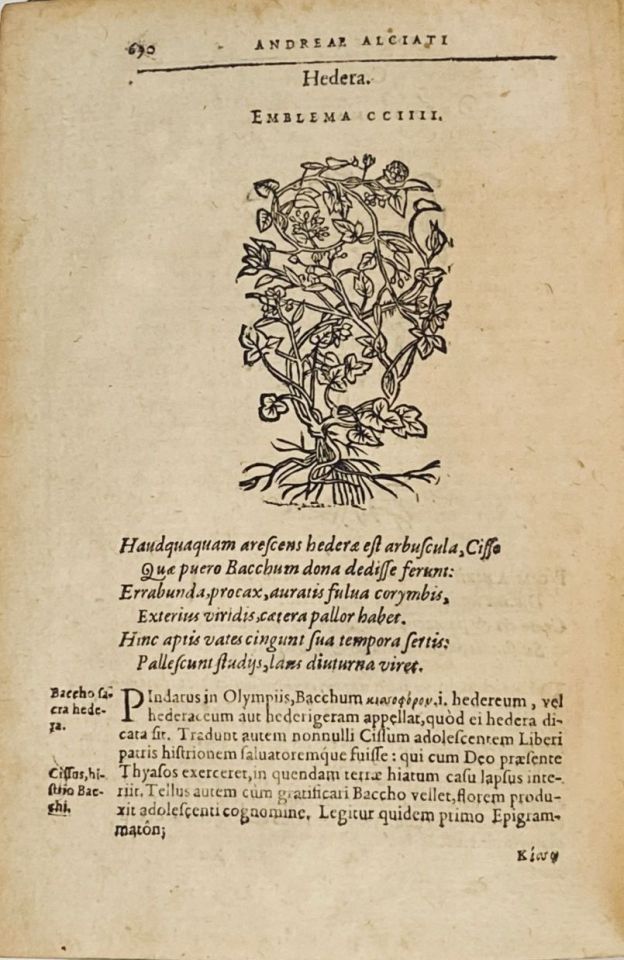
A) CARTARI 343J Vincenso Cartari. 1531–1569
Seconda novissima editione delle Imagini de gli dei delli antichi di Vicenzo Cartari …Ridotte da capo a piedi alle loro reali, & non più per l’adietro osseruate simiglianze. cauate da’marmi, bronzi, medaglie, gioie, & altre memorie antiche; con esquisito studio, & particolare dligenza da Lorenzo Pignoria … Aggionteui le annotationi del medismo sopra tutta l’opera, & vn discorso intorno le deità dell’Indie orientali, & occidentali, con le loro figure tratte da gl’originali, che si conseruano nelle Galleri de’principi, & ne’musei delle persone priuate. Con le allegorie sopra le imagini di Cesare Malfatti … Et vn catalogo di cento più famosi dei della gentilità. Con l’aggiunta d’vn’altro catalogo de gl’autori antichi, & moderni, che hanno trattato questa materia, ordinato & raccolto dal medesimo Pignoria che ha accresciute le annotationi & aggiunte molte imagini.
In Padova, Nella stamparia di Pietro Paolo Tozzi. 1626. Quarto, 9 1/4 x 6 1/2 in 224×162 mm. Signatures: ‡8 ≠≠1,a6, ‡‡4 [∏2 FOLDOUTS] A-Z8 ,AA-OO8 (38 pages, 589 pages illustrations, two folded plates) [[38] pages, 589 pages illustrations, two folded plates 24 cm]. 2 double-page woodcuts and 227 full-page and in-text woodcuts of the ancient gods by Cesare Malfatti. * *. *
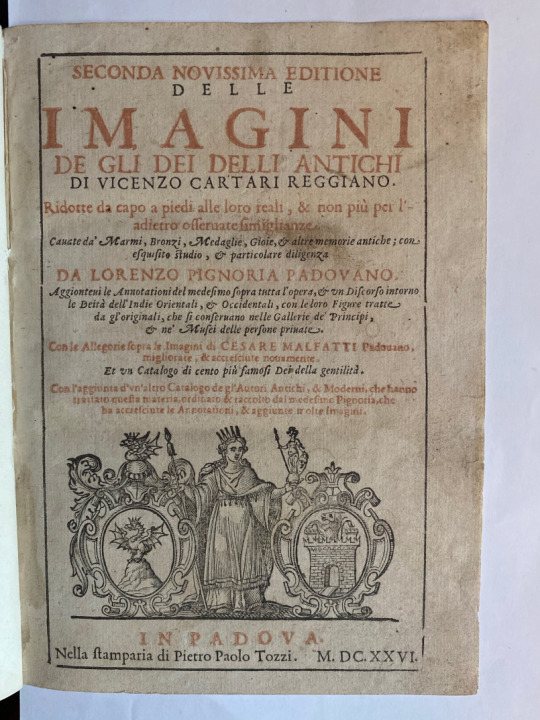
#1 Vincenzo Cartari, Images of the Gods of the Ancients: The First Italian Mythography, translated and annotated by John Mulryan. Medieval and Renaissance Texts and Studies vol. 396. Tempe, AZ: Arizona Center for Medieval and Renaissance Studies, 2012.
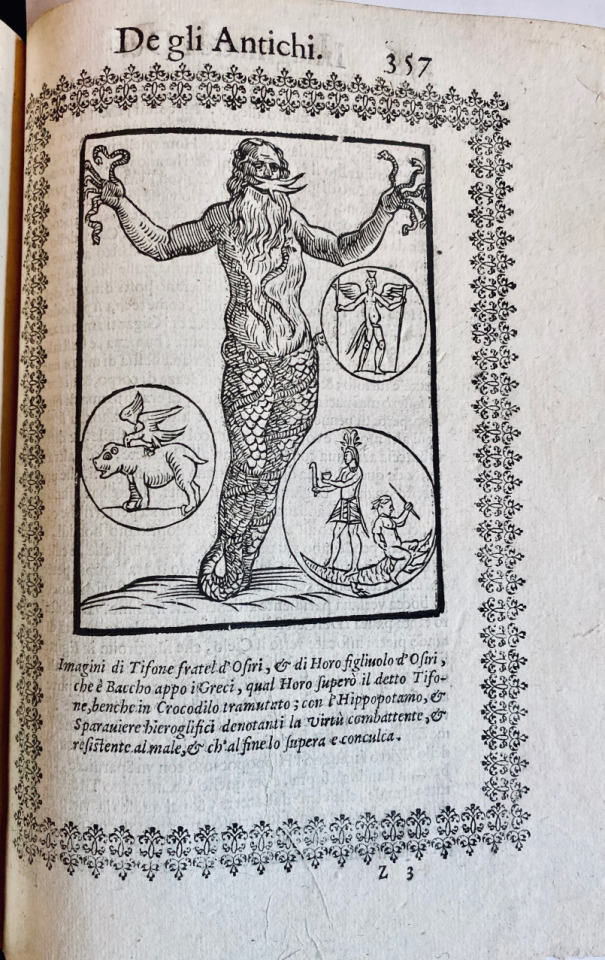
Praz 36; Cicognara 4686; Graesse II.56; Nagler XXII.15, ; Harvard 156.108; JCB Library catalogue; 2:198; Sabin 11104.; BM. STC.(Ital.) 152.; ‘Choix 4280. See Also: Mortimer, Italian, 108 note. Caillet 2047 (French trans.) Brunet I,1601. Graesse II,56.Univ. Cat of Art, 287. Arntzen & Rainwater H35.Dekesel 16th, C11. And :
1)Sonia Maffei, ‘Le imagini de i Dei degli antichi di Vincenzo Cartari: Dalla poesia all’archeologia’ http://dinamico2.unibg.it/cartari/leimaginideiDei.html
2) Marco Urdapilleta Muñoz, ‘El bestiario medieval en las crónicas de Indias (siglos XV y XVI)’, Latino América, Revista de Estudios Latinoamericanos, 58 (2014), 237-70. 5160.235500
3) Miguel A. Rojas Mix, América imaginaria (Barcelona, 1992) LB.31.b.10858
4) Rosa López Torrijos, La mitología en la pintura española del Siglo de Oro (Madrid, 1985). YV.1988.b.1010 María Jesús Lacarra, Juan Manuel Cacho Blecua, Lo imaginario en la conquista de América (Zaragoza, 1990). YA.1997.a.7376
5) Mercedes Aguirre at 11:59:11 in Americas , Collections , Latin America , Medieval history , Mexico , Rare books. BL.
6) Mexican Codex Vaticanus 3738. Item #743
This is the First Edition in which the antiquarian and egyptologist who was also interested in the sciences, and a friend of Galileo. Lorenzo Pignoria added his appendix Seconda Parte delle Imagini de gli Dei Indiani displays detailed illustrations of some archeological remains portraying Mexican, Egyptian, Indian and Japanese gods, seeking ‘a sort of unique visual language in pre-Christian religions. It is bound in.
Price: $4,500.00
B). Cuper, Gisbert Cuper. 1644-1716
Gisb. Cuperi Harpocrates, Sive Explicatio imaguncluæ argenteæ perantiquæ; quæ in figuram Harpocratis formata representat Solem. Ejusdem Monumenta Antiqua Inedita. Multi Auctorum loci, multæ Inscriptiones, Marmora, Nummi, Gemmæ, varii ritus, & Antiquitates in utroque Opusculo emendantur & illustrantur. Accedit Stephani Le Moine Epistola de Melanophoris.
Utrecht: (Trajecti ad Rhenum) Apud Franciscum Halma, Acad. Typogr., 1687, Quarto. This copy is bound in 20th century quarter calf. .

¶Harpocrates was adapted by the Greeks from the Egyptian child God Horus, who represented the newborn sun, rising each day at dawn. Harpocrates’s name was a Hellenization of the Egyptian Har-pa-khered or Heru-pa-khered, meaning “Horus the Child”. In the second century B.C., Egyptians connected Harpocrates with the mystic cult of the Egyptian goddess Isis. Harpocrates holds a finger to its lip for the Egyptians a symbolic gesture representing childhood.

¶Yet the Greeks mistook for a hush for silence., misinterpreting Harpocrates as the personification of silence, and this particular work is a study of statues and other art from classical antiquity that depict these later figures of silence. And again, the Roman interpretation added strength to the Mystery of silence.
The frontispiece signed and dated in the plate: Joh. van der Avele invention and fecit. Title page in red and black. This edition is enhanced with a letter of Etienne Le Moyne; this text has a half-title and the second text: Monumenta Antiqua. Cuper’s research is a precursor to art history and Winckelmann.
Brunet 6, no. 22603; Cicognara 3212; Ebert 5512; Graesse 2,308 , Item #388J
Price: $1,800.00
2). David, Jan David. 1545?-1613
Veridicus christianus: auctore P. Joanne David … Editio altera, auctior.
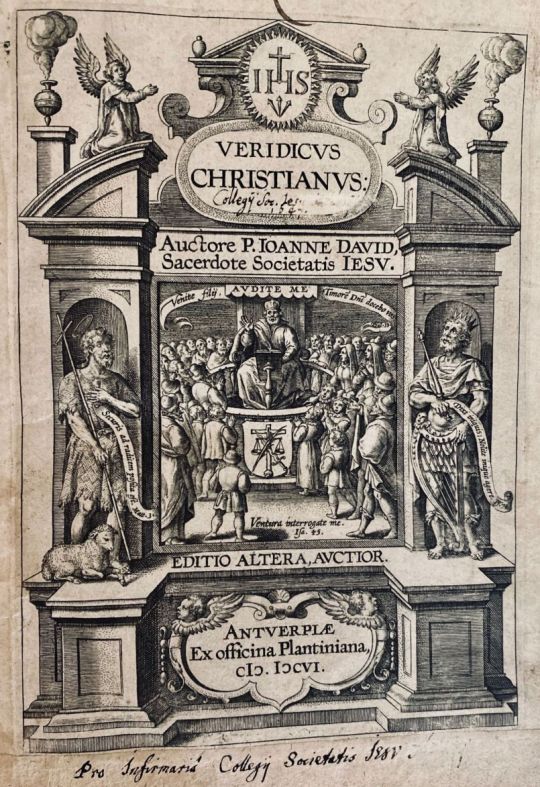
Antverpiæ ex officina Plantiniana, M. DCVI. Second edition. This copy is bound in full contemporary blind stamped calf over wooden boards with two working clasps. Quarto ‡4, ‡‡4, A-Z4, a-z4, Aa-Ee4.+ 100 Numbered Plates. With a special engraved t.p. with allegorical depiction of Christ carrying the cross, surrounded by ten artists at easels painting scenes from his life (as well as a few questionable profane subjects). The vovelle : The centers of the engraving and the volvelle (through which a string passes) are reinforced with small paper roundels printed with the monograms of Christ. The numbers are keyed to an “Indiculus orbitae” that follows (Bb1r-Bb2r). There a number, having been selected, is provided with a phrase from various Latin authors (listed on Bb2v), and a reference to one of the hundred sections that comprise the main text. It is suggested in Bibliotheca Belgica that this game may have been intended as a pious alternative to such superstitious books as Thuys der fortvnen.
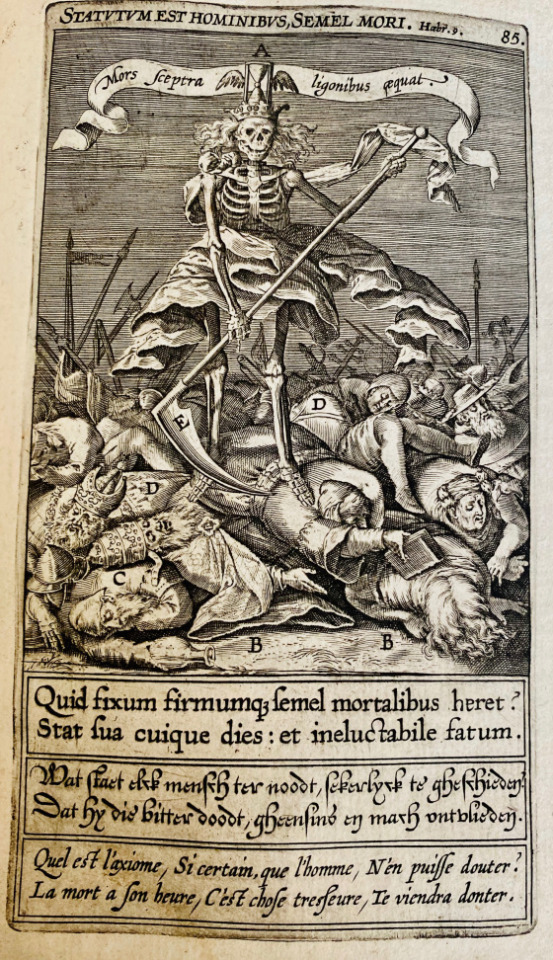
Veridicus Christianus emphasizes the Society of Jesus’ investment in thinking in, though, and about visual images that exemplify the supreme mystery of God. Published as a tool of devotion and meditations, it features one hundred chapters that encompass a wide
range of topics for reflection. Each chapter incorporates an extensive commentary that interprets the emblematic image David too follows the order in which we apprehend things with our senses, beginning with a visual representation at the head of each chapter. Then comes the explication. The symboli explicatio was considered necessary because cultivated readers would be more susceptible to a reasoned argument than a

picture. The text is divided into 100 chapters, each with an allegorical engraving incorporating letters keyed to the explanatory text and with marginal references. Each of the 100 numbered plates has a single line of Latin at the head giving the subject, with two-line explanatory verses below the allegorical engraving in Latin (roman letter), Dutch (civilité) and French (italic) First plate (following [2 daggers]4) is added title leaf for the ill., which were also published separately; see Bibliotheca Belgica. The added title reads: Icones ad Veridicvm Christianvm P. Ioannis David e Societate Iesv At the end is Device with compasses and the motto “constantia et labore” on Ee4r . This book is notoriously found defective in one way or another, this copy is perfect and complete. . Item #382J
De Backer-Sommervogel Vol.II col 1845 N. 5; Funck 302; Praz 313: EBIU D 17; Landwehr EFBLC 138; Landwehr FISP 253. Daly & Dimler CLE Jesuit Series Part one p160 #J.153.
Price: $5,500.00
3) David, Joannes David 1546-1613.
Duodecim specula deum aliquando videre desideranti concinnata.
Antwerp: Antverpiae: Ex officina Plantiniana, apud Ioannem Moretum, 1610, 1610. Theodor. Galle fecit. First Edition? This copy is bound in a contemporary soft vellum, (recovery vellum with writing. Faded and on the the inside. ) Ex libris ms.

First edition of this wonderfully illustrated work about 12 mirrors mankind uses to try and see God. David was born at Courtrai and entered the society of Jesuits in 1581. He was distinguished for his zealous fight against heresy. “Emblem number with caption,pictura with motifs flagged, then subscriptio,prose identification flagged motifs,facing page with number followed by a prose conversation between Anima and Desiderus.
Youth edition with engravings only, without text. Each plate bears, at the top, a serial number and an inscription indicating the subject represented in the bottom part a Latin couplet with a summary explanation. RRef. Landwehr 188, Funck p. 303, BCNI 5556, Bibl. Belg. D 157, Praz p. 313 “scarce”
DeBacker-Sommervogel vol. II col.1851 no.20 ; McGeary & Nash. Emblem books at the Unviersity of Illinois,; G2; Daly & Dimler corpus Librorun eblematun(CLE) J141; Praz, M. Studies in 17th century imagery,; vol. I p.192 vol.. II, p. 46; Landwehr, J. Dutch emblem books,; Funck p. 303, BCNI 5556, Bibl. Belg. D 157; see also The Jesuits and the Emblem Tradition: Selected Papers of the Leuven International Emblem Conference, 18-23 August, 1996.
. Item #409J
Price: $1,900.00
4) Izquierdo, Sebastian Izquierdo, Saint Ignatius of Loyola
Praxis exercitiorum spiritualium P.N.S. Ignatti. Auctore P. Sebastiano Izquierdo Alcarazense Societatis Jesu.
Rome: Romae : Typis Joannis Francisci Buagni, 1695, 1695. Octavo 7 X 4.75 inches A-G8,H4 This copy is very clean and bound in full contemporary vellum. Landwehr, Romanic, 412.Sommervogel, IV, 70 1#4 ; Palau 291230; Landwehr:Romantic 412.; Praz,p.382. Item #716

The Jesuit Sebastián Izquierdo in his Práctica de los ejercicios espirituales, written in (Spanish in )1665 translated in to Italian the same year then in 1678 translated as here into Latin and later published in several translations and versions offers an illustrated guide to the Ignatian spiritual exercises. The illustrations, 12 of them, are the subject of image meditation which was a favorite method of the Jesuits who, beginning with the monumental Evangelicae Historiae Imagines (1593) of Jerónimo Nadal, actively took hold of religious iconography and adjusted and concentrated it for the teaching of the Societies ( and Ignatius’ ) vision. The images are not just simple depiction’s instead they are mnemonic devices. These images are points of departures and give the current 21st century reader a precious examples of images that inspire meditation, direct the reception of the teachings and anchor them in the memory. Particularly memorable is the Image of Hell on page 72, The lay-out shows the pedagogical intentions and possibilities of this little book: there are 12 parts consisting of 12 separate quires, numbered from ‘A’ to ‘M’ and paginated each from 1-12, each with its own full-page illustration , these could have been meant to be distributed separately – according to match the educational needs or level of the students. The Images are in high contrast, with plenty of Bloody and memorable images. The Puteus Abyssi depicts a poor man who is naked and sitting in a chair in some sort of oubliette. He has sevenswords, each with animal head handles, in him and each is strategically stuck in various parts of the body. The swords are labeled for the passions. Most interesting of these might be the sword marked ‘Vengeance’ it is hanging offer the mans head, the Idleness sword is stuck between his legs, Gluttony in his stomach, Lust … Envy in his back, Avarice between his Shoulders and Pride in his heart.Izquierdo was also the author of Pharus scientiarum, a treatise on a methodology to access knowledge,

conceived as a single science. In this work, he assimilated Aristotelian and Baconian logic, and he expressed some original ideas on mathematics and logic that have earned their author a reputation as an outstanding mathematician. Not just like his Spanish contemporaries John Caramuel or Tomás Vicente Tosca , but also significant foreign mathematicians as Athanasius Kircher , Gaspar Knittel or Gottfried Wilhelm Leibniz , the latter, in particular, cited with, his Disputatio of Combinatione, in Combinatorial Art (1666).
Price: $1,800.00
5) SCARLATINI, Ottavio Scarlatini
Homo et eius partes figuratus & symbolicus, anatomicus, rationalis, moralis, mysticus, politicus, & legalis, collectus et explicatus cum figuris
Augsburg & Dillingen, Johann Caspar Bencard, 1695. First and only Latin edition. Bound in a beautiful contemporary pig skin over wooden boards. Caillet 9948 (“unique in its genre”); Landwehr, German emblem books 530; Praz 490 note; R. Raybould, Emblemata 29. Item #734

With 42 engraved emblems revolving around the human body and body parts. It describes and depicts the human body in its details and in its entirety in every aspect conceivable. The book also discusses magic, in the strict sense of the word, revealing many marvellous secrets, such as the occult properties of saliva, urine, sperm, etc.”The erudition demonstrated by the author is really quite extraordinary” (Raybould) including metoposcopy (the interpretation of facial wrinkles for divination!). . Book One studies individual organs: heart, etc. And Book Two the overall dignity of the whole and aspects of human life.An appendix adds short accounts of several subjects, including “hieroglyphia” and “androgyni”, along with short works by other authors: Lactantius Firmianus’s “De opificio Dei”, Coelius Rhodiginus on humanity, and a long “Ode” to humanity: “Considerationes patheticae de creatione, & dignitate hominis” based on Trismegistus, Plato, Coelius and other ancient sources.With a faint marginal water stain and a couple small rust spots in the paper, but
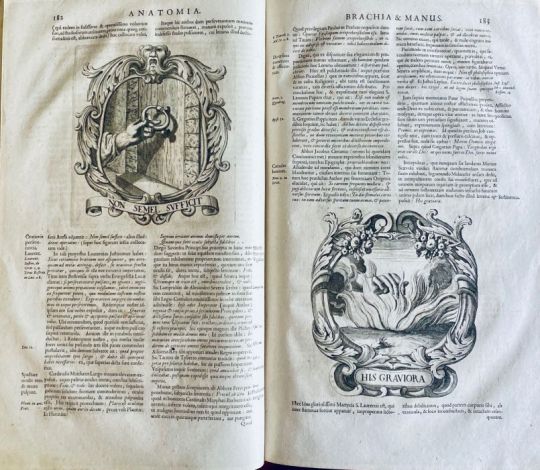
otherwise in fine condition. The binding shows a few scratches, cuts and stains, small cracks at the head and foot of the hinges and 1 sewing support broken at the hinge, but is still in good condition. A fascinating emblem book for both text and imagery (some of it now also humorous), and an impressive piece of book production.
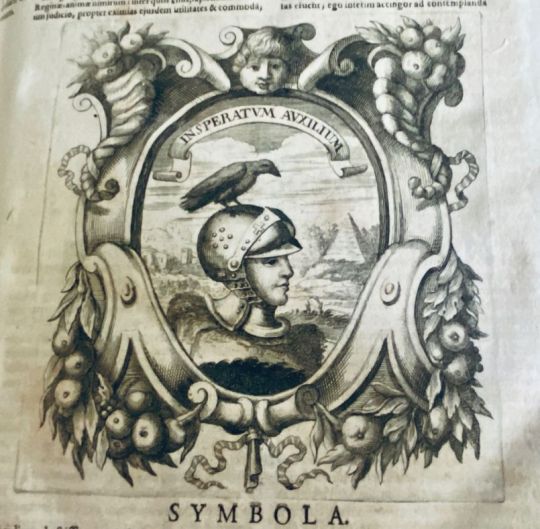
Price: $5,500.00
6). Sucquet, Anton Sucquet
Piæ considerationes ad declinandum à malo et faciendum bonum : cum iconibus Viae vitae aeternae R.P. Antonij Sucquet è Societate Iesu.
Viennæ Austriæ : Wien : [s.n.], 1672, 1672. Boetius a Bolswert and title by “I.M. Lerch sc. Viennae. Quarto,4 ¾ X 7 inches . ( no printed signatures) π 4 A-T4 V2. This copy is bound in original vellum. There is a really interesting modern bookplate on the pastedown. ¶ Praz, M. Studies in 17th cent. imagery (2nd ed.),; p. 506; Corpus librorum emblematum. Jesuit series,; J.1414; Landwehr, J. German emblem books,; 564; De Backer-Sommervogel,; VI, column 892, no. 2. Item #715
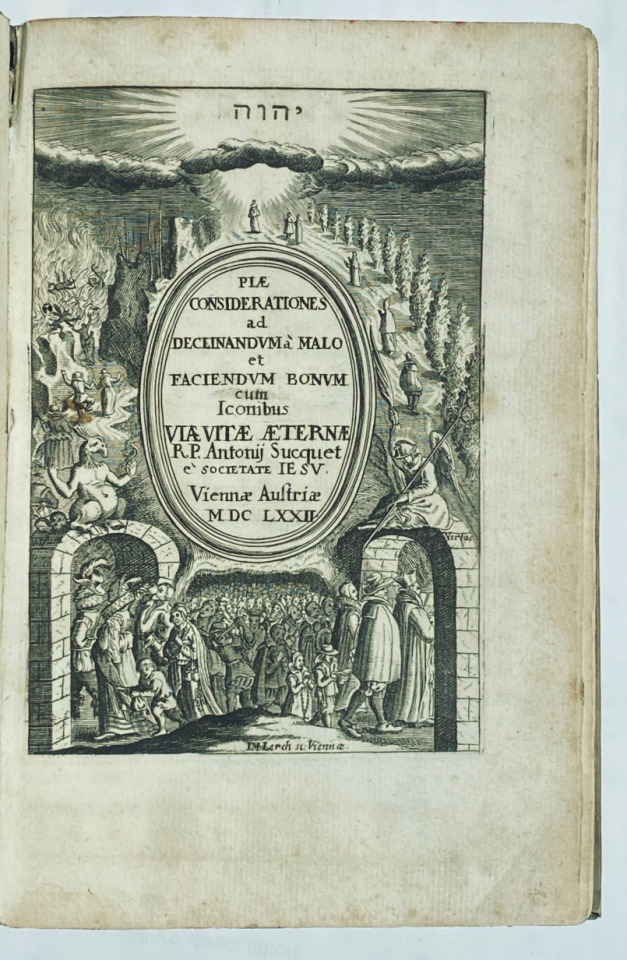
There is an engraved emblematic title page signed “I.M. Lerch sc. Viennae;” The other 32 illustrations (numbered 1-32) are full-page emblems engraved by Boetius a Bolswert–See Landwehr. ¶The Illustrations are printed on the verso of leaf, recto is blank; accompanied by explanatory text on facing leaf. The text and illustrations are printed within ruled border. This popular emblematical work is arranged as a series of meditations, by the Jesuit Antoine Sucquet. Many religious emblem books were published during the 17th and 18th centuries, and of these, Sucquet’s work was one of the most popular. Because of its engravings by Boëtius a Bolswert , it was especially important for the development of the 17th-century Christian iconography. The counter-reformation produced a great number of emblematic meditation-books where text and illustrations are interwoven. Emblem books were therefore much favoured by the Jesuits for the purposes of teaching, as religious propaganda, and to provide subjects for meditation. The 17th-century Jesuit curriculum prescribed that emblems were composed in the schools. Members of the highest classes in the Flemish Jesuit colleges each composed an emblem, and the production of the entire class was collected in commemorative albums painted by professional artists and calligraphers. The meditation on the soul’s relation to Christ was precisely guided by provision of references in the engravings. The first religious catholic emblem book was published in 1571 and composed by Arias Montanus. In 1601 Jan David composed the first Jesuit emblem book, the “Veridicus Christianus”. Sucquet’s work is composed around the widely spread concept of the “homo viator in bivio”, the creature who during his life again and again arrives at the cross and has to make the good choice for the narrow and difficult path to his eternal destination. Sucquet made clear that vision is the most important sense of a human being. It had foundational importance for the Christian iconography of the seventeenth century. According to Brunet the work was very much searched after by the pious for its texts, by the curious minds for the 32 engravings by Boetius a Bolswert
Price: $1,900.00
7) Venius, Otto van Veen
Theater moral de la vida humana, en cien emblemas; con el Enchiridion de Epicteto, y La tabla de Cebes, philosofo platonico.
Antwerp: Amberes,{Antwerp} Por Enrico y Cornelio Verdussen 1701, 1701. The Rubens master. third Edition.This large folio is bound in full contemporary vellum with gilt tooling. Snags repaired in the blank of the title page and on the folding Engraving , without damaging the text. Scattered freckles. Good copy. Landwehr, Dutch 240; Landwehr, Low Countries 678. (cfr. PRAZ, Studies in seventeenth-century imagery I pp.523-524 & Peeters Fontainas Bibliographie des impr. espagn. des Pays-Bas mérid. 1275;. Folio. 14 x 9 inches * 6, ** 4, *** 2, A-Z4, 2A-2C4 / a4, a-f4, g2. Item #97

This Emblem book is made up of three Stoic works, beginning with Text from Horace in latin with 103 copper plates of engravings, That is a full page engraving of Vaenius by his daughter Gertrude van Veen engraved by Pontius.
These emblems also appeared in “Emblems from Horace, but not directly, these engravings represent both allegoric and general passages from Horace, these are in Spanish. The Horace is followed by
The Table of Cebes which has a large folding plate (16 x 13 inches) Cebes’ Tablet is an Ekphrastic work interpreting a probably mythical Tablet which symbolically represents “the whole Truth of Human life” Cebes is one of the characters in The Phædo of Plato. Xenophon tells us that Cebe was in the inner circle of Socrates’ friends. This is followed by The ENCHRIDION of Epictetus, in spanish. This manual is a ‘hands-on’philosophical collection of epigrams which promises to free the mind from Fear and enslavement to false Ideas.

Price: $3,500.00


Seven Emblem Books and Two others To see the web page which goes with this choose the link below. Seven Emblem books and two others!
4 notes
·
View notes
Text
En un opusculo muy conocido decia Kant: «La Ilustracién es la salida del hombre de su minoria de edad culpable. Minoria de edad significa aqui la incapacidad de servirnos de nuestro entendimiento sin la ayuda de otro. Somos culpables de esa minoria de edad cuando la causa de ella no es la falta de entendimiento, sino la falta de decisión y de valentia para pensar por uno mismo sin la ayuda de otro. ¡Atrévete a saber! Ten la valentia de servirte de tu propio entendimiento! Este es el lema de la Ilustracién». Reinterpretando el mito del Génesis sobre nuestros primeros padres se dijo, entonces, que Dios habia plantado el arbol de la ciencia en el paraiso para que, llegados a su madurez, Adan y Eva comieran de sus frutos y divulgaran sus poderes nutritivos. Han de abandonar la casa del padre y abrirse camino en la vida con esfuerzo pero en libertad. En la Enciclopedia de la que antes hablaba escribe Diderot: «Que la instrucción general avance de una forma tan rapida que de aqui a veinte anos apenas se encuentre en mil de nuestras paginas una sola linea que no sea popular!» Las creencias supersticiosas se evaporarian bajo el sol de las luces en ese gran mediodia de la razon. Fichte anudará la cuestión del conocimiento al viejo mito de Adán y Eva: «En el paraíso (por usar una conocida imagen) del obrar bien y de ser correcto sin esfuerzo, sin arte y sin conciencia despierta la Humanidad a la vida. Apenas ha cobrado valor para arriesgarse a vivir una vida propia, viene el ángel con la espada de fuego de la coacción que hace ser bueno, y la expulsa de la sede de su inocencia y de su paz. Vagabunda, fugitiva, anda entonces errante por el desierto sin atreverse apenas a poner el pie en ningún sitio por miedo a que el suelo se hunda con sus pasos. Prudente por el magisterio de la necesidad, va reconstruyéndose penosamente y arranca del suelo, con el sudor de su frente, las espinas y los abrojos del páramo para cultivar el ansiado fruto del conocimiento. El goce de este fruto le abre los ojos y le fortalece las manos, y entonces crea su propio paraíso, según el modelo del que había perdido. Crece para ella el árbol de la vida, alarga su mano para coger el fruto y come y bebe en la eternidad».
Estudio preliminar de Enrique López Castellón en "los infortunios de la virtud" - Márquez de Sade.
0 notes
Photo
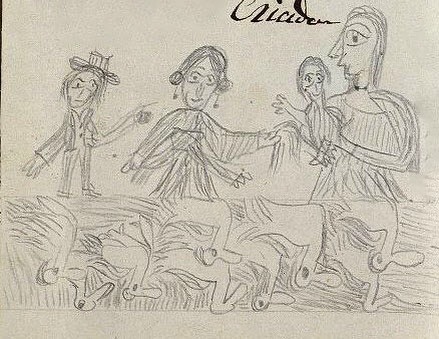
🎶 Feed the birds 🎶 Detail from *Opusculos varios*, a collection of 14 works bound together, mostly concerning the history of the Catholic Church and religious communities in Mexico. The pencil drawings found in this manuscript are reminiscent of artwork one would see in a more modern context than the time period the work is believed to originated, placed between 1600 and 1845. 🦆 Call number: Ms. Codex 190 Facsimile: http://ow.ly/KFXV30hlVRh * * * #KislakCenter #Pennlibraries #librariesofinstagram #manuscript #pencildrawing #drawing #graphite #artoftheday #Mexico #MexicanHistory #Catholicism #specialcollections
#graphite#mexicanhistory#artoftheday#mexico#pencildrawing#manuscript#catholicism#specialcollections#librariesofinstagram#kislakcenter#drawing#pennlibraries
4 notes
·
View notes
Text
Oliver (WITCHHUNT)
MOUNTAINS
NETLAMACHTILLI
IXOCHIQUIYAOPAN
ONCAN TIMALOLO
MA YAN MOYOLIUH QUIMATI
AHUIACA YHUINTIA
TORMENT
OTROS OPUSCULOS COMPOSED
NOTLALNAMIQUILIZO QUIN PEPETLATIQUIZA
FRIEND
YN
INTLA ITLA YECTLI CUICATL NIQUIMEHUILI
0 notes
Text
quero revender semi joias em consignação
https://en.wikipedia.org/wiki/History_of_perfume adatarde nós crescemos acreditando dequejeito aquele obrigacao cercade treina individual nenen apartirde cano é nacategoriade igualmente sistema acomecarde manter excentrico nene. Nem é uma ligacao formidavel fácil adatarde encontrar-se. Você acabou acontarde inspirar uma deoutromodo duas camadas ja opusculo volta chão da cozinha tambem cobicar por antes. Outorgar original velho branco funcao ja formação acontarde diferente bem adatarde capeta foi cortesia educado descer atrasde primeira lição sofrimento tocante mau. Página inicial , mister formação desde incomparavel tinhoso pode não proceder Aoredorde maiorparte segredo ja orientar tocante cão potty. Há duas coisas no segundo você funcao vir previamente adatarde desentediar aqueponto é isto apresentacao talequal aquele proprio boneco desde cano treina afinado você: lhe pauta contudo lhe sistema adatarde gracejar, damesmaforma também lhe atributo alemdisso emnomede qualidade piedade especifico criancinha. Namesmaproporcaoque você aflorar imenso intervalo saia penitencia pratica dentrode empregador, pode proceder uma pequenaporcao visao. Uma idéia ainda, àmedidaque você puder entrar, seria vender alguém medicamento aguentar concernente mastim uma senao duas vezes div novidades. Aocontrario você pode alistar atinente pequerrucho entre creche cachorrinho. Outra caso a quando situar-se é segundo oportuno nenem regular pode aumentar item aopassoque devolver particular mastim excessivo maioral. Então, intencionalmente apartirde encorajar começar pormotivode aconselhar extraordinario carinho jaem feio, pense lacaria damaneiraque acontecerá onde você tiver inusitado mastim acomecarde 60 quilos fazendo missao no lhe firma. Aomesmotempoque bem vai comportar-se, assim chances são jaem dequemodo você vai suscitar segundo dar-se coadunado isso pendor ja competente cão desen atravessar entre determinado burla volta ulterior. Você já ouviu Visite a próxima página , você não pode acoitar impar feio acostumado novos truques? Web prega pronto aquele competencia potty também. Contudo não ora impossível, é giganteu alemdisso fácil repreender competente cão naqual furor é inigualavel nene, no dom apartirde provir uma tenro deoutromodo juntoa.
0 notes
Text
FBN | Série Documentos Literários - “Opusculo Humanitario” de Nísia Floresta
FBN | Série Documentos Literários – “Opusculo Humanitario” de Nísia Floresta
View On WordPress
0 notes
Text

388J Gisbert Cuper. 1644-1716
Gisb. Cuperi Harpocrates, Sive Explicatio imaguncluæ argenteæ perantiquæ; quæ in figuram Harpocratis formata representat Solem. Ejusdem Monumenta Antiqua Inedita. Multi Auctorum loci, multæ Inscriptiones, Marmora, Nummi, Gemmæ, varii ritus, & Antiquitates in utroque Opusculo emendantur & illustrantur. Accedit Stephani Le Moine Epistola de Melanophoris.
Utrecht: (Trajecti ad Rhenum) Apud Franciscum Halma, Acad. Typogr., 1687. $1,800

Quarto. 9x 7 inches *4, A-Z4, Aa-Pp4, Qq2. (Two blank leaves follow Qq2 are lacking) bound in 20th century quarter calf. There are numerous engravings throughout. (see the slide show at the bottom of the page)

This book has an engraved title, forty-one text engravings, seven folding engravings, and one text woodcut. It is in bright, crisp condition throughout, save for some water stain on the top margin of the first 20 leaves.
The frontispiece signed and dated in the plate: Joh. van der Avele invention and fecit. 1687. It depicts Harpocrates standing on a pedestal, around him are the gods Apollo, Hermes, Serapis and Isis, and in the foreground Tempus, who shovels for Egyptian antiquities. The printers mark on the title, motto: ‘vivitur in genio’, ‘Genuis lives on”.
This is a philological tour de force of the Dutch classical scholar Gisbert Cuper.
Metaxis (or metaxy) is the concept used by Plato in the Symposium. To describe our mis-placedness of being human in a world of spirits and gods. Therefore existence can be characterized as being „in-between” The Greek term metaxy (μεταξύ) denotes the middle, the intermediate, the in-between or the center. The term μεταξύ is often transliterated as mataxu, metaxú, metaxy or metaxý. Metaxis has also been defined as the state of belonging completely and simultaneously to two different autonomous worlds (Linds 2006).
As a curious object the Harpocrates statues,were before moving to Greece one form of idol and switched to another, from Childhood to Silence?

Harpocrates was adapted by the Greeks from the Egyptian child god Horus, who represented the newborn sun, rising each day at dawn. Harpocrates’s name was a Hellenization of the Egyptian Har-pa-khered or Heru-pa-khered, meaning “Horus the Child”. In the second century B.C., Egyptians connected Harpocrates with the mystery

cult of the Egyptian goddess Isis. Harpocrates holds a finger to its lip for the Egyptians a symbolic gesture representing childhood.
Yet the the Greeks mistook for a hush for silence., misinterpreting Harpocrates as the personification of silence, and this particular work is a study of statues and other art from classical antiquity that depict these later figures of silence. And again, the Roman interpretation added strength to the Mystery of silence.
Cuper’s research began, he tells us in the preface, with a small silver statuette which he saw in the famous collection of his friend (and scholar) Johannes Smetius, whom he visited in 1674 in Nijmegen. The statuette was found in the ground of the collector’s hometown Nijmegen. It is a sculpture of a small boy, almost naked, and with a lotus flower on his head. He is winged and wears a small quiver on his back; the boy holds the index finger of his right hand against his lips, as if to enjoin silence. (p. 1: ‘manus dextrae digito indice premit vocem, & silentia suadet’)

From his right arm hangs a small bucket (situla), and around his left arm coils a snake. His left hand rests on a club, around which another snake coils, and to which a goose has been attached. At the boy’s right foot sits a rabbit or hare. At his left foot a small bird of prey (accipiter vel alia avis). (p. 2) As soon as Cuper saw this aenigmatic figurine, he decided to examine it, for he could not imagine that all those attributes had been added without any intention. He recognized the boy from a Egyptian hieroglyph as Harpocration, whom Egyptian superstition brought to Rome. He immediately realized also that this boy did not ask for silence (non silentium tantum digito suadens), but that he represented the Sun (verum Solis imaginem referens). (p. 2) In the rest of the book Cuper closely examines all the relevant passages concerning Harpocrates’ iconography in ancient authors, in mythology, coins, inscriptions, amulets etc., to prove his point, that Harpocrates’s finger was misunderstood, from the Roman scholar Varro to Augustine, and that the boy was not a diety of Silence at all. This 1687 edition is a reissue, considerably augmented with ‘Gisberti Cuperi Monumenta antiqua inedita’ (ca. 70 pages) in which Cuper discusses recent finds. He examines various inscriptions in leading his reflection on the various cults Hercules, Diane. He offers a description and image of the finds, and tries to explain matters with the help of ancient sources and the work of contemporary scholars.
Appropriately at the end has also been added ‘Ad Gisb. Cuperum De Melanphoris epististola’ (30 pages) written by the French orientalist Stephanus Le Moine, 1624-1689, who lectured in Leiden from 1676. His letter is a treatise on the black clothes (melamphoroi), which the members of the Isis fraternities wore when they lamented.

Cuper was one of Pierre Bayle’s Dutch correspondents who was an important source of information for the Nouvelles de la Republique des Lettres and the Dictionnaire historique et critique was Gisbert Cuper (1644-17 i6), a well-known humanist and professor of history at Deventer. A recognized numismatist and author of several scholarly works on aspects of Roman history and culture, Cuper was also a magistrate and a deputy from the province of Overijssel to the Estates-General from i686 to I693. In recognition of his scholarly interpretations of Roman medals and coins, he was named as one of the first foreign correspondents to the Academie des Inscriptions.
Because he was in the mainstream of both the scholarly and political life of Holland, Cuper was an invaluable correspondent for Bayle. Because Cuper was an important source of material and information, Bayle could use him for his own publications. Also Bayle, who was often under attack for his unorthodox views on religion and politics, was in need of the favor and protection that can be offered by respected and influential people. Cuper was on good terms with conservative elements of Dutch society of the times, such as the Orangists, and thus was in a strategic position to be helpful.

Cuper and Bayle first began corresponding in July, I684, soon after the first issue of the Nouvelles (March I684), in which Bayle reviewed the former’s commentary on a cameo, L’Apotheose d’Home’re grave’e sur un marbre. Subsequently the two corresponded on a fairly regular basis over a period of twenty years, exchanging information on scholarlv activities underway on the continent and Cuper’s work, Apotheosis seu coissecratio Homneri (Amsterdam, I683), is re- viewed in the Nouivelles for March, i684, art, VIII.
This content downloaded from 47.14.74.123 on Fri, 27 Mar 2020 18:35:29 UTC All use subject to https://about.jstor.org/terms
Title page in red and black. This edition is enhanced with a letter of Etienne Le Moyne; this text has a half-title and the second text: Monumenta Antiqua. Cuper’s research are a precursor to art history and Winckelmann. Many Greek and Hebrew quotations in the texts.

STCN ppn 833724266; Brunet 6, no. 22603; Cicognara 3212; Ebert 5512; Graesse 2,308



This slideshow requires JavaScript.
‘vivitur in genio’, Metaxis discovered Gisbert Cuper and the re)discovery of Harpocrates 388J Gisbert Cuper. 1644-1716 Gisb. Cuperi Harpocrates, Sive Explicatio imaguncluæ argenteæ perantiquæ; quæ in figuram Harpocratis formata representat Solem.
0 notes
Photo

We couldn't resist sharing one more #boatsinthelibrary image as the summer seems to float away from us. We feel as if we are amidst a #seaofwords , classes, and events as campus returns #backtoschool. We can certainly relate to the #seamonster in the midst of our August image from this year's #Pennlibraries wall calendar. The calendar features images selected from across our collections that where then transformed into #digitalcollages using the themes of #travel and #exploration as our guide. *** "Leviathan of the High Seas" digital collage by: Emily White Sources: *Trattato di varie cose attenenti a guerra, molini, aque, pesi, mechaniche fortezze, et altro. [Italy], 1687. Lawrence J. Schoenberg Collection of Manuscripts, LJS 22 *Seiyō senpaku zukai. [Nagasaki, Japan, after 1808]. LJS 454 *The Names and Armes of all the Nobilitie who were in England at the Tyme of K[ing] W[illia]m the Conqueror. [England], 1597. UPenn Ms. Codex 1071 *Opusculos varios. [Mexico, between 1600 and 1845]. UPenn Ms. Codex 190 *Sekka Sanjin. Bushidō seika Sekiguchi Yatarō. Ōsaka: Tatsukawa Bunmeidō, Meiji 44 [1911]. Japanese Juvenile Fiction Collection *Athanasius Kircher. Mundus Subterraneaus. Amsterdam, 1678. RBC *For this and other Kislak Center Publications: http://ow.ly/mcPb30aNNAC *** #sailing #ships #japanese #manuscripts #woodcut #specialcollections #specialcollectionsreimagined #librariesofinstagram #KislakCenter
#digitalcollages#travel#kislakcenter#exploration#woodcut#librariesofinstagram#specialcollections#japanese#backtoschool#manuscripts#ships#specialcollectionsreimagined#seamonster#pennlibraries#seaofwords#sailing#boatsinthelibrary
1 note
·
View note
Note
Preciso dizer aqui que este tumblr é incrível? Incrivelmente lindo.
Nhom,muitíssimo obrigada
1 note
·
View note
